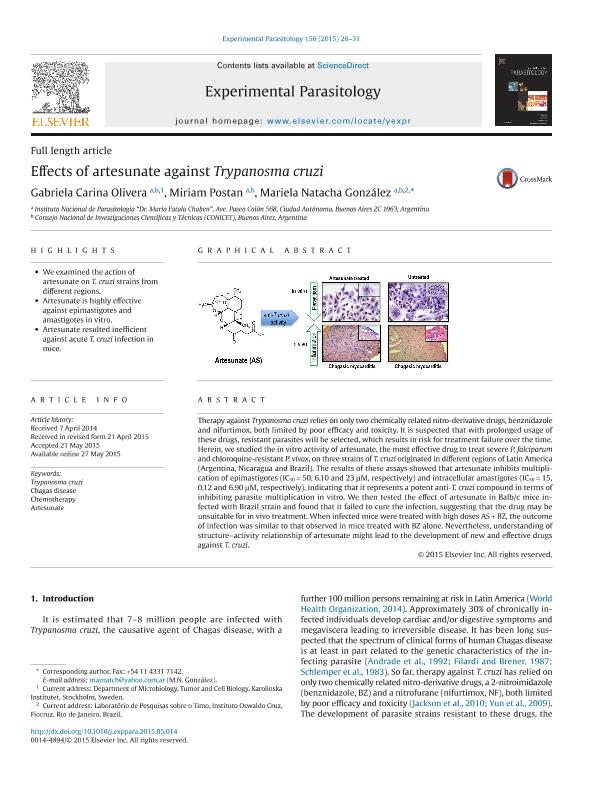Artículo
Effects of artesunate against Trypanosma cruzi
Fecha de publicación:
09/2015
Editorial:
Academic Press Inc Elsevier Science
Revista:
Experimental Parasitology
ISSN:
0014-4894
Idioma:
Inglés
Tipo de recurso:
Artículo publicado
Clasificación temática:
Resumen
Therapy against Trypanosma cruzi relies on only two chemically relatednitro-derivative drugs, benznidazole and nifurtimox, both limited by poorefficacy and toxicity. It is suspected that with prolonged usage of these drugs, resistant parasites will be selected, which results in risk for treatment failureover the time. Herein, we studied the in vitro activity of artesunate, the mosteffective drug to treat severe P. falciparum and chloroquine-resistant P. vivax, on three strains of T. cruzi originated in different regions of Latin America(Argentina, Nicaragua and Brazil). The results of these assays showed thatartesunate inhibits multiplication of epimastigotes (IC50 = 50, 6.10 and 23 µM,respectively) and intracellular amastigotes (IC50 = 15, 0.12 and 6.90 µM,respectively), indicating that it represents a potent anti-T. cruzi compound interms of inhibiting parasite multiplication in vitro. We then tested the effectof artesunate in Balb/c mice infected with Brazil strain and found that it failedto cure the infection, suggesting that the drug may be unsuitable for in vivotreatment. When infected mice were treated with high doses AS + BZ, the outcomeof infection was similar to that observed in mice treated with BZ alone.Nevertheless, understanding of structure-activity relationship of artesunatemight lead to the development of new and effective drugs against T. cruzi.
Palabras clave:
Trypanosoma Cruzi
,
Chagas Disease
,
Chemotherapy
,
Artesunate
Archivos asociados
Licencia
Identificadores
Colecciones
Articulos(SEDE CENTRAL)
Articulos de SEDE CENTRAL
Articulos de SEDE CENTRAL
Citación
Olivera, Gabriela Carina; Postan, Miriam; González, Mariela Natacha; Effects of artesunate against Trypanosma cruzi; Academic Press Inc Elsevier Science; Experimental Parasitology; 156; 9-2015; 26-31
Compartir
Altmétricas




